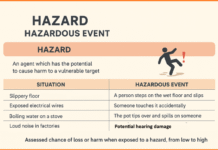Contents
Introduction to Total Case Incident Rate (TCIR)
The Total Case Incident Rate (TCIR) is a pivotal metric in the feild of occupational safety and health. It serves as a benchmark for measuring the frequency of workplace injuries, illnesses, and accidents. By quantifying the instances of such incidents per 100 full-time employees over a specified period, TCIR enables organizations to evaluate their safety programs’ effectiveness accurately. This metric is integral in identifying potential hazards and implementing preventive measures to ensure a safer working environment.
Understanding the importance of TCIR extends beyond internal assessments. It plays a critical role in comparing safety performance across various industries and companies. By standardizing the measurement of workplace incidents, TCIR allows for a level playing field where businesses can benchmark their safety performance against industry norms. This comparison is crucial for identifying areas of improvement and fostering a culture of continuous safety enhancement.
Moreover, the calculation and reporting of TCIR are often mandated by regulatory bodies. Organizations are required to adhere to standards set forth by agencies such as the Occupational Safety and Health Administration (OSHA) in the United States. These regulations ensure that companies maintain a comprehensive record of workplace incidents, thereby promoting transparency and accountability in occupational safety practices. Non-compliance with these regulatory requirements can result in penalties and undermine an organization’s reputation, further underscoring the significance of accurately calculating and reporting TCIR.
In summary, the Total Case Incident Rate (TCIR) is an essential tool for assessing and improving workplace safety. By providing a clear metric for the frequency of workplace incidents, it helps organizations safeguard their employees and maintain regulatory compliance. As we delve deeper into the intricacies of TCIR, its calculation, and its application, it will become evident why this metric is indispensable in today’s safety-conscious work environments.
Components of the TCIR Formula
The Total Case Incident Rate (TCIR) is a crucial metric for assessing workplace safety. To fully understand its implications, it is essential to break down the formula used to calculate it. The TCIR formula is typically expressed as:
(Number of Incidents x 200,000) / Total Hours Worked by All Employees.
The numerator of the formula, “Number of Incidents,” represents the total number of work-related injuries and illnesses that occur within a specified period. These incidents can range from minor injuries requiring first aid to more severe cases resulting in lost workdays or restricted duties. Accurate reporting of all incidents is vital for a reliable TCIR calculation, as underreporting can lead to a misleadingly low rate, masking potential safety issues that need addressing.
The denominator, “Total Hours Worked by All Employees,” accounts for the cumulative number of hours worked by all employees during the same period. This includes both full-time and part-time employees, as well as temporary workers. The inclusion of total hours worked helps normalize the number of incidents relative to the workforce size, providing a more meaningful comparison across different organizations or time periods. It ensures that the TCIR reflects the actual exposure to workplace risks.
The factor 200,000 is a standardizing constant used in the TCIR formula. This figure represents the number of hours 100 employees would work in a year, assuming a 40-hour workweek and 50 workweeks per year. By multiplying the number of incidents by 200,000, the formula scales the incident rate to a standard level, facilitating comparisons between organizations of varying sizes and across different industries. This standardization allows for a more consistent evaluation of workplace safety performance, regardless of the size of the workforce.
Understanding these components and their roles in the TCIR formula is fundamental for accurately assessing and improving workplace safety. By diligently tracking and analyzing these metrics, organizations can identify trends, implement effective safety measures, and ultimately foster a safer work environment for all employees.
Calculating the Numerator of the TCIR Formula
The numerator in the Total Case Incident Rate (TCIR) formula is the total number of incidents within a specific period. Calculating this figure accurately is essential for determining the TCIR. According to the Occupational Safety and Health Administration (OSHA), a recordable incident encompasses work-related injuries, illnesses, and fatalities that necessitate medical treatment beyond first aid, result in days away from work, or involve restricted work or job transfers.
To begin, it is imperative to define what qualifies as a recordable incident. OSHA standards provide clear guidelines on this matter. A recordable incident includes any injury or illness that is work-related and meets one or more of the following criteria:
1. The incident requires medical treatment beyond first aid.
2. The incident results in days away from work.
3. The incident involves restricted work or job transfer.
4. The incident leads to loss of consciousness.
5. The incident causes a significant injury or illness diagnosed by a physician or other licensed healthcare professional.
Identifying and categorizing incidents accurately is crucial. Employers should ensure that all incidents meeting these criteria are documented meticulously. This involves maintaining thorough records of injuries and illnesses, which can be facilitated by using standardized forms like OSHA’s Form 300, the Log of Work-Related Injuries and Illnesses.
Accurate record-keeping is a cornerstone of calculating the numerator correctly. Employers should implement robust reporting procedures to ensure that all incidents are reported promptly and documented accurately. This includes training employees on the importance of reporting incidents and how to do so effectively. Regular audits of incident records can also help in identifying any discrepancies and ensuring that the data remains accurate.
In summary, adhering to OSHA standards and maintaining accurate records are essential for calculating the numerator in the TCIR formula. By following these guidelines, employers can ensure they have a precise count of recordable incidents, which is fundamental for calculating the Total Case Incident Rate accurately.
Practical Examples and Applications of TCIR
The Total Case Incident Rate (TCIR) serves as a critical metric for evaluating workplace safety across various industries. By understanding its application through practical examples, organizations can effectively compute and utilize TCIR to enhance their safety programs. Let’s explore step-by-step calculations using hypothetical data, and discuss how TCIR data can be instrumental in identifying trends and setting performance goals.
Consider a manufacturing company with the following hypothetical data for a given year:
- Total number of recordable incidents: 15
- Total number of hours worked by all employees: 400,000
TCIR = (Number of recordable incidents × 200,000) / Total hours worked
Applying the data:
- TCIR = (15 × 200,000) / 400,000
- TCIR = 3.75
Organizations can leverage TCIR data for several purposes. Firstly, it helps in identifying safety trends over time. For instance, if the TCIR has been gradually increasing, it may signal deteriorating safety conditions, necessitating a review of safety protocols. Conversely, a decreasing TCIR suggests improvements in workplace safety.
Furthermore, TCIR is invaluable in benchmarking safety performance. By comparing their TCIR with industry standards or competitors, organizations can gauge their relative safety standing. This comparative analysis can highlight areas needing improvement and inspire the adoption of best practices from industry leaders.
Setting safety performance goals is another crucial application of TCIR. Companies can establish specific TCIR targets, driving continuous safety improvements. For example, a goal to reduce TCIR by 10% annually can foster a proactive safety culture, encouraging regular safety audits, employee training, and hazard assessments.
Let’s consider a real-world example from the construction industry. A construction firm noticed a TCIR spike from 4.2 to 5.6 over two years. By analyzing incident reports, the firm identified common causes such as inadequate fall protection and insufficient employee training. Targeted interventions, including enhanced safety training programs and stricter enforcement of safety protocols, eventually reduced their TCIR to 3.9, demonstrating the effectiveness of data-driven safety strategies.
Understanding and applying TCIR through practical examples equips organizations with the tools to monitor, evaluate, and enhance their safety performance. By leveraging TCIR data, companies can establish robust safety programs and foster a culture of continuous improvement, ultimately ensuring a safer work environment for all employees.





